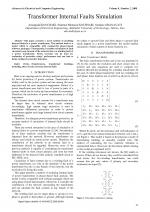| 2/2008 - 4 |
Transformer Internal Faults SimulationKOOCHAKI, A. |
| Extra paper information in |
| Click to see author's profile in |
| Download PDF |
Author keywords
transformers, transformer windings, modeling, short circuit currents, internal fault
References keywords
power(11), transformer(8), internal(7), fault(6), systems(5), model(4), faults(4)
Blue keywords are present in both the references section and the paper title.
About this article
Date of Publication: 2008-06-02
Volume 8, Issue 2, Year 2008, On page(s): 23 - 28
ISSN: 1582-7445, e-ISSN: 1844-7600
Digital Object Identifier: 10.4316/AECE.2008.02004
Web of Science Accession Number: 000264815000004
SCOPUS ID: 77954678891
Abstract
This paper presents a novel method of modeling internal faults in a power transformer. The method leads to a model which is compatible with commercial phasor-based software packages. Consequently; it enables calculation of fault currents in any branch of the network due to a winding fault of a power transformer. These currents can be used for evaluation of protective relays' performance and can lead to better setting of protective functions. |
| References | | | Cited By |
Web of Science® Times Cited: 10 [View]
View record in Web of Science® [View]
View Related Records® [View]
Updated 3 weeks, 6 days ago
SCOPUS® Times Cited: 16
View record in SCOPUS® [Free preview]
View citations in SCOPUS® [Free preview]
[1] State-of-the-Art Fault Detection and Diagnosis in Power Transformers: A Review of Machine Learning and Hybrid Methods, Mashifane, Lebo Dina, Mendu, Bongumsa, Monchusi, Bessie Baakanyang, IEEE Access, ISSN 2169-3536, Issue , 2025.
Digital Object Identifier: 10.1109/ACCESS.2025.3546861 [CrossRef]
[2] Energy Based Correlation Method for Location of Partial Discharge in Transformer Winding, JEYABALAN, V., USA, S., Advances in Electrical and Computer Engineering, ISSN 1582-7445, Issue 1, Volume 9, 2009.
Digital Object Identifier: 10.4316/aece.2009.01008 [CrossRef] [Full text]
[3] Routine Test Analysis in Power Transformers by Using Firefly Algorithm and Computer Program, Zile, Mehmet, IEEE Access, ISSN 2169-3536, Issue , 2019.
Digital Object Identifier: 10.1109/ACCESS.2019.2939764 [CrossRef]
[4] Application of artificial intelligence to stator winding fault diagnosis in Permanent Magnet Synchronous Machines, Nyanteh, Yaw D., Srivastava, Sanjeev K., Edrington, Chris S., Cartes, David A., Electric Power Systems Research, ISSN 0378-7796, Issue , 2013.
Digital Object Identifier: 10.1016/j.epsr.2013.05.018 [CrossRef]
[5] Non Linear Modelling of a New Three-Phase High Voltage Transformer with Magnetic Shunts, El Ghazal, N., Belhaiba, A., Chraygane, M., Russian Electrical Engineering, ISSN 1068-3712, Issue 4, Volume 94, 2023.
Digital Object Identifier: 10.3103/S1068371223040065 [CrossRef]
[6] A Novel Anti-maloperation Gas Relay for Internal Fault Protection of Oil-immersed Transformer, XUE, B., YI, W., LI, Y., LIU, C., TIAN, S., MA, J., ZHANG, T., WAN, S., Advances in Electrical and Computer Engineering, ISSN 1582-7445, Issue 1, Volume 25, 2025.
Digital Object Identifier: 10.4316/AECE.2025.01003 [CrossRef] [Full text]
[7] Temperature Analysis in Power Transformer Windings Using Created Artificial Bee Algorithm and Computer Program, Zile, Mehmet, IEEE Access, ISSN 2169-3536, Issue , 2019.
Digital Object Identifier: 10.1109/ACCESS.2019.2915343 [CrossRef]
[8] Detailed Simulation of Transformer Internal Fault in Power System by Diakoptical Concept, KOOCHAKI, A., KOUHSARI, S. M., Advances in Electrical and Computer Engineering, ISSN 1582-7445, Issue 3, Volume 10, 2010.
Digital Object Identifier: 10.4316/aece.2010.03008 [CrossRef] [Full text]
[9] A New Method of Improving Transformer Restricted Earth Fault Protection, KRSTIVOJEVIC, J. P., DJURIC, M. B., Advances in Electrical and Computer Engineering, ISSN 1582-7445, Issue 3, Volume 14, 2014.
Digital Object Identifier: 10.4316/AECE.2014.03005 [CrossRef] [Full text]
[10] Modelling of Switched Mode Fly-back Supply for Engineering Education, TRIP, N. D., LUNGU, S., POPESCU, V., Advances in Electrical and Computer Engineering, ISSN 1582-7445, Issue 1, Volume 10, 2010.
Digital Object Identifier: 10.4316/aece.2010.01018 [CrossRef] [Full text]
Disclaimer: All information displayed above was retrieved by using remote connections to respective databases. For the best user experience, we update all data by using background processes, and use caches in order to reduce the load on the servers we retrieve the information from. As we have no control on the availability of the database servers and sometimes the Internet connectivity may be affected, we do not guarantee the information is correct or complete. For the most accurate data, please always consult the database sites directly. Some external links require authentication or an institutional subscription.
Web of Science® is a registered trademark of Clarivate Analytics, Scopus® is a registered trademark of Elsevier B.V., other product names, company names, brand names, trademarks and logos are the property of their respective owners.
Faculty of Electrical Engineering and Computer Science
Stefan cel Mare University of Suceava, Romania
All rights reserved: Advances in Electrical and Computer Engineering is a registered trademark of the Stefan cel Mare University of Suceava. No part of this publication may be reproduced, stored in a retrieval system, photocopied, recorded or archived, without the written permission from the Editor. When authors submit their papers for publication, they agree that the copyright for their article be transferred to the Faculty of Electrical Engineering and Computer Science, Stefan cel Mare University of Suceava, Romania, if and only if the articles are accepted for publication. The copyright covers the exclusive rights to reproduce and distribute the article, including reprints and translations.
Permission for other use: The copyright owner's consent does not extend to copying for general distribution, for promotion, for creating new works, or for resale. Specific written permission must be obtained from the Editor for such copying. Direct linking to files hosted on this website is strictly prohibited.
Disclaimer: Whilst every effort is made by the publishers and editorial board to see that no inaccurate or misleading data, opinions or statements appear in this journal, they wish to make it clear that all information and opinions formulated in the articles, as well as linguistic accuracy, are the sole responsibility of the author.



